If ![]() is an infinite continued
fraction, I want to define its value to be the limit of the
convergents:
is an infinite continued
fraction, I want to define its value to be the limit of the
convergents:
![]()
For this to make sense, I need to show that this limit exists.
In what follows, take as given an infinite continued fraction ![]() . Let
. Let
![]()
![]()
![]()
![]()
Proposition.
(a) ![]() .
.
(b) ![]() .
.
Proof. (a)
![]()
(b)
![]()
![]()
Proposition.
![]()
That is, the odd convergents get smaller, the even convergents get bigger, and any odd convergent is bigger than any even convergent.
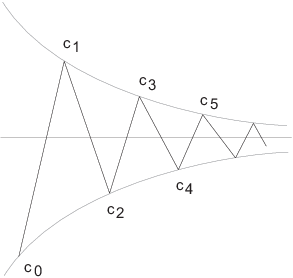
Proof. If k is even, then
![]()
This shows that the even terms get bigger.
If k is odd, then
![]()
This shows that the odd terms get smaller.
Finally, I have to show any odd term is bigger than any even term. Note that it's true if the terms are adjacent:
![]()
Next, do the general case. Let ![]() be an odd term and let
be an odd term and let ![]() be an even term. Then
be an even term. Then
![]()
The first inequality is true because odd terms decrease. The second inequality is true because I just observed that an odd term is bigger than an adjacent even. Finally, the last inequality is true because even terms increase.
I've shown that any odd term is bigger than any even term, and that
completes the proof.![]()
Here's a numerical example. The first ten convergents for the golden
ratio ![]() are
are

The odd convergents get smaller, the even convergents get bigger, and any odd convergent is bigger than any even convergent.
Proposition. ![]() for all
for all ![]() .
.
Proof. I'll induct on k. ![]() , so the result holds for
, so the result holds for ![]() . Take
. Take ![]() , and assume it holds for numbers less than
or equal to k. I'll prove that it holds for
, and assume it holds for numbers less than
or equal to k. I'll prove that it holds for ![]() .
.
![]()
(The last inequality used ![]() .) This completes the induction step.
.) This completes the induction step.![]()
Theorem. Let ![]() be an infinite continued
fraction with
be an infinite continued
fraction with ![]() for
for ![]() , and let
, and let ![]() be the k-th convergent. Then
be the k-th convergent. Then
![]()
Proof. Consider the sequence of odd convergents
![]()
This is a decreasing sequence of numbers, and it's bounded below --- by any even convergent, for example. A standard result from analysis (see, for example, Theorem 3.14 of [1]) asserts that such a sequence must have a limit, so
![]()
Likewise, consider the sequence of even convergents:
![]()
This is an increasing sequence of numbers that's bounded above --- by any odd convergent, for example. The result from analysis mentioned above says that the sequence has a limit:
![]()
I have to show that the two limits agree.
The previous result implies that ![]() and
and ![]() , so
, so
![]()
Now let ![]() .
. ![]() , so by the Squeezing
Theorem of calculus,
, so by the Squeezing
Theorem of calculus,

Since the odd and even terms approach the same limit, ![]() exists.
exists.![]()
Definition. ![]() .
.
What can I say about the value of an infinite continued fraction?
Theorem. Let ![]() be an infinite continued
fraction with
be an infinite continued
fraction with ![]() for
for ![]() . Then
. Then ![]() is irrational.
is irrational.
Proof. Write ![]() for short. I want to
show that x is irrational. Suppose on the contrary that
for short. I want to
show that x is irrational. Suppose on the contrary that ![]() , where p and q are integers. I
will show this leads to a contradiction.
, where p and q are integers. I
will show this leads to a contradiction.
Since the odd convergents are bigger than x and the even convergents are smaller than x,
![]()
Then
![]()
![]()
![]()
![]()
![]()
![]()
![]()
Notice that this inequality is true for all k, and that ![]() is an integer. But q
is fixed, and
is an integer. But q
is fixed, and ![]() ,
so if I make k sufficiently large eventually
,
so if I make k sufficiently large eventually ![]() will become bigger than q. Then
will become bigger than q. Then ![]() will be a fraction less than
1, and I have an integer
will be a fraction less than
1, and I have an integer ![]() caught between 0 and a
fraction less than 1. Since this is impossible, x can't be
rational.
caught between 0 and a
fraction less than 1. Since this is impossible, x can't be
rational.![]()
Now I know that every infinite continued fraction made of positive integers represents an irrational number. The converse is also true, and it gives an algorithm for computing the continued fraction expansion.
Proposition Let ![]() be irrational. Let
be irrational. Let ![]() , and
, and
![]()
Then for all ![]() ,
,
![$$x = [a_0; a_1, a_2, \ldots x_k] = a_0 + \dfrac{1}{a_1 + \dfrac{1}{\matrix{\noalign{\vskip2pt} \ddots & \cr & \dfrac{1}{a_{k - 1} + \dfrac{1}{x_k}}}}}$$](infinite-continued-fractions71.png)
Thus, ![]() represents the "infinite
tail" of the continued fraction.
represents the "infinite
tail" of the continued fraction.
Proof. For ![]() , the claim is that
, the claim is that ![]() , which is true by definition.
, which is true by definition.
Assume that the result holds for n. Then
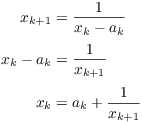
Then
![]()
This proves the result for ![]() , so the result is true for
, so the result is true for ![]() by induction.
by induction.![]()
Theorem. Let ![]() be irrational. Let
be irrational. Let ![]() , and
, and
![]()
Then
![]()
Proof.
Step 1. ![]() is irrational for
is irrational for ![]() .
.
Since x is irrational and ![]() , the result is true for
, the result is true for ![]() .
.
Assume that ![]() and that the result is true
for
and that the result is true
for ![]() . I want to show that
. I want to show that ![]() is irrational.
is irrational.
Suppose on the contrary that ![]() , where
, where ![]() . Then
. Then
![]()
Now all the ![]() 's are clearly integers (since
's are clearly integers (since
![]() means they're outputs of the
greatest integer function), so
means they're outputs of the
greatest integer function), so ![]() is the sum of an
integer and a rational number. Therefore, it's rational, so
is the sum of an
integer and a rational number. Therefore, it's rational, so ![]() is rational, contrary to the induction
hypothesis.
is rational, contrary to the induction
hypothesis.
It follows that ![]() is irrational. By
induction,
is irrational. By
induction, ![]() is irrational for all
is irrational for all ![]() .
.
Step 2. The ![]() 's are positive integers for
's are positive integers for ![]() .
.
I already observed that the ![]() 's are integers.
's are integers.
Let ![]() . Since
. Since ![]() , the definition of the greatest
integer function gives
, the definition of the greatest
integer function gives
![]()
But ![]() is irrational, so
is irrational, so ![]() . Hence,
. Hence,
![$$\eqalign{ a_k <\ & x_k < a_k + 1 \cr 0 <\ & x_k - a_k < 1 \cr \noalign{\vskip2pt} x_{k + 1} & = \dfrac{1}{x_k - a_k} > 1 \cr \noalign{\vskip2pt} a_{k + 1} & = [x_{k + 1}] \ge 1 \cr}$$](infinite-continued-fractions108.png)
Since ![]() , this proves that the
, this proves that the ![]() 's are positive integers for
's are positive integers for ![]() .
.
Step 3.
![]()
First, I'll get a formula for x in terms of the p's, q's, and a's.
Then I'll find ![]() and show that it's less than something which goes to
0.
and show that it's less than something which goes to
0.
Recall the recursion formulas for convergents:
![]()
The right sides only involve terms up to ![]() (and p's and q's of smaller indices).
Therefore, the following fractions have the same p's and q's through
index k:
(and p's and q's of smaller indices).
Therefore, the following fractions have the same p's and q's through
index k:
![]()
Using the preceding proposition and the recursion formula for convergents, I get
![]()
Therefore,
![]()
![]()
Take absolute values:
![]()
Now
![]()
Therefore,
![]()
![]()
![]()
By an earlier lemma, ![]() and
and ![]() , so
, so
![]()
Now ![]() , so by the Squeezing Theorem
, so by the Squeezing Theorem
![]()
This implies that
![]()
Example. Compute the first 5 terms of the
continued fraction expansion of ![]() .
.
Here are the first two steps:
![]()
![]()
Continuing in this way, I obtain:
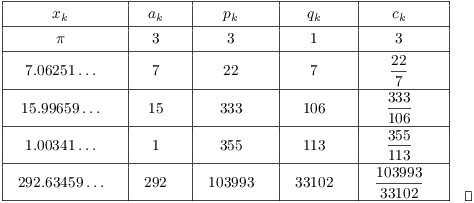
Example. Compute the first 5 terms of the
continued fraction expansion of ![]() .
.
![]()
![]()
Here are the first 5 terms:
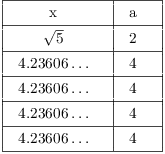
In fact, the continued fraction expansion for ![]() is
is ![]() .
.![]()
Theorem. The continued fraction expansion of an irrational number is unique.
Proof. Suppose there are two continued
fractions for the irrational number x, where ![]() and
and ![]() for
for ![]() :
:
![]()
I want to show that ![]() for all k.
for all k.
Recall that the even convergents are smaller than x and the odd convergents are greater than x.
Therefore,
![]()
Now
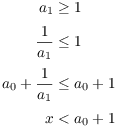
Thus, ![]() is an integer less than x, and the
next larger integer
is an integer less than x, and the
next larger integer ![]() is greater than x.
This means that
is greater than x.
This means that ![]() .
.
The same reasoning applies to the b's. Therefore, ![]() , so
, so ![]() .
.
Hence,
![$$\eqalign{ [a_0; a_1, a_2, \ldots] & = [b_0; b_1, b_2, \ldots] \cr \matrix{a_0 + \dfrac{1}{a_1 + \dfrac{1}{a_2 + \vphantom{\dfrac{1}{a_3}}}} & & \cr & \ddots & \cr} & = \matrix{b_0 + \dfrac{1}{b_1 + \dfrac{1}{b_2 + \vphantom{\dfrac{1}{b_3}}}} & & \cr & \ddots & \cr} \cr \matrix{\dfrac{1}{a_1 + \dfrac{1}{a_2 + \vphantom{\dfrac{1}{a_3}}}} & & \cr & \ddots & \cr} & = \matrix{\dfrac{1}{b_1 + \dfrac{1}{b_2 + \vphantom{\dfrac{1}{b_3}}}} & & \cr & \ddots & \cr} \cr [a_1; a_2, a_3, \ldots] & = [b_1; b_2, b_3, \ldots] \cr}$$](infinite-continued-fractions153.png)
I can continue in the same way to show that ![]() for all k.
for all k.![]()
Here's a summary of some of the important results on infinite continued fractions:
1. An irrational number has a unique infinite continued fraction expansion.
2. The algorithm for computing the continued fraction expansion of an irrational number x is:
![]()
Then
![]()
3. If ![]() is the continued
fraction expansion of an irrational number, then
is the continued
fraction expansion of an irrational number, then ![]() is an integer, and
is an integer, and ![]() is a positive integer for
is a positive integer for ![]() .
.
4. If ![]() is a continued
fraction expansion and
is a continued
fraction expansion and ![]() for
for ![]() , then
, then ![]() is irrational.
is irrational.
5. If ![]() is the
continued fraction expansion of an irrational number and
is the
continued fraction expansion of an irrational number and ![]() and
and ![]() are defined by the recursion formulas for
convergents, then
are defined by the recursion formulas for
convergents, then
![]()
Example. Compute the first 6 convergents in
the continued fraction expansion for ![]() .
.
Use them to illustrate the last result for ![]() .
.
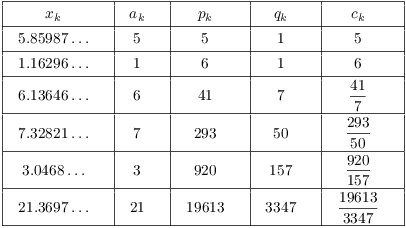
Now
![]()
Thus, in this case,
![]()
[1] Walter Rudin, Principles of Mathematical Analysis (![]() edition). New York: McGraw-Hill Book
Company, 1976.
edition). New York: McGraw-Hill Book
Company, 1976.
Copyright 2019 by Bruce Ikenaga